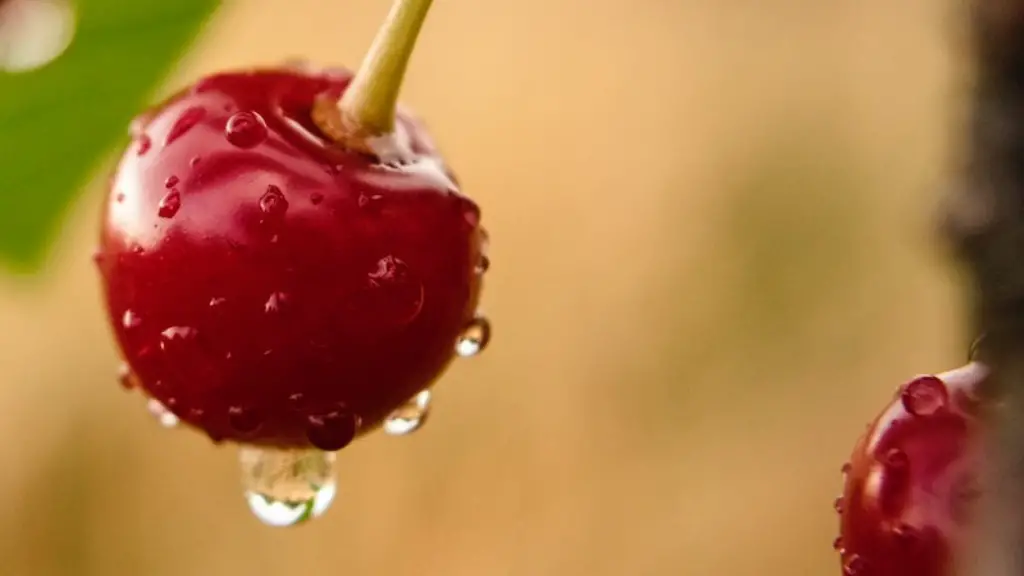Cherries are a popular treat for their sweet taste and vibrant colors and growing your own cherry tree from a stone is a satisfying and enjoyable experience. While the process is not complicated, it does require patience and dedication. There are some important tips and tricks to remember when growing a cherry tree from a stone that should help increase the success rate.
First, it is important to select a cherry stone that is healthy and not damaged. When looking for the right stone, you should look for one that is smooth on the outside and has a light-colored pit inside. Avoid cherry stones that are cracked, discolored, or have other deformities as these will not be able to germinate.
You should also take note of the type of cherry tree you plan to grow. Different varieties have varying degrees of difficulty when it comes to growing from seed, so it is best to do a bit of research first. Tart cherries are known to be easier to grow than sweet cherries, for instance. Once you have chosen the best type of cherry for you, it is time to plant the stone.
When ready to plant, you should place the cherry stone in a moist potting mix, about 2 inches into the soil. Make sure to keep the soil fairly moist until the seedling has emerged. The best time to plant cherry stones is usually in early spring or late winter. After covering the seed in soil, water regularly and keep an eye out for signs of germination.
If the cherry stone has germinated successfully, then it should be transplanted to its permanent location outside. Careful consideration should be given to the location of the tree. It should be in an area that gets plenty of sunlight, at least eight hours each day. Poor drainage should be avoided, as trees that are regularly exposed to waterlogged soil may struggle to survive. A space with a rich and loamy soil is preferable.
Once the tree has been planted in its new location, it should be regularly watered and fertilized. A liquid fertilizer should be applied once a month during the growing season to provide nutrients. Ensure the soil is kept lightly moist but not soggy, and mulch should be applied to help retain moisture and protect the roots. Pruning should also be done to promote strong, healthy growth. Careful pruning can help create a balanced canopy and boost the cherry’s yield.
Finally, you should be aware of common pests and diseases that can harm your cherry tree. Aphids and leafhoppers are common pests and can cause damage to the leaves and fruits of the tree. If you notice any pests or diseases on the tree, it is best to treat them quickly to prevent further damage. The best way to keep pests and diseases at bay is to keep your cherry tree healthy and strong with regular watering and fertilizing.
Fertilization
Fertilization is an important part of growing a cherry tree from a stone and should be done carefully. Too much fertilizer can lead to over-fertilization, which can be detrimental to the health of the tree. The best practice is to use a balanced fertilizer that contains nitrogen, phosphorus, and potassium. A slow-release fertilizer is ideal as it will provide more consistent nutrition to the tree, as compared to quick- release fertilizer which can lead to excessive growth.
It is recommended to fertilize the tree every three months, taking care to water the soil after application. Avoid applying fertilizer directly onto the tree, as this can burn the tree’s roots. Also, be sure not to over-fertilize as this can cause the tree to become stressed, which may lead to stunted growth or even death.
If the soil is already rich in nutrients, additional fertilization may not be necessary, so be sure to check the soil before beginning. By following these guidelines, your cherry tree should have the best chance of success.
Harvesting
Once your cherry tree has been fully matured, it can be harvested for its sweet fruits. Generally, a cherry tree will produce its first fruits after about three years of growth. Typically, you can expect your tree to yield about 50 to 80 cherries a year, depending on the variety.
It is important to know when to pick the cherries as over-ripe fruit can spoil quickly. To test if the cherries are ready to be harvested, you can tap them gently. If they give off a hollow sound, they are ready to be picked. Then, the cherries should be stored in an airtight container to be enjoyed at a later time.
Pruning
Pruning plays an important role in keepingcherry trees healthy, as it helps keep the tree’s growth in check and prevents overcrowding. Light pruning should be done before, during, and after flowering to ensure healthy blooming. At this time, the branches should be cut back to promote new growth, and any dead or broken branches should be removed.
Also, prune excess branches and stems for a more even canopy. This will prevent your tree from becoming too top heavy and make harvesting easier. Also, ensure any pruning is done correctly to avoid damaging the tree’s bark.
Disease Prevention
Cherry trees are prone to certain diseases, including powdery mildew, brown rot, and black knot. It is important to recognize the symptoms of these diseases, in order to act quickly to prevent them from spreading. Powdery mildew can be identified by white spots on the leaves, while brown rot may manifest as dry, black spots on the fruits.
If you notice symptoms of any of these diseases, you should treat the area with an appropriate fungicide. It is also important to maintain good hygiene and remove any dead or diseased branches. This will help prevent any of the diseases from spreading and help keep the tree healthy.
Watering
Watering is an important aspect of cherry tree care. The tree should receive about one to two inches of rainfall per week. If the rainfall does not meet this requirement, then watering the tree manually is necessary. The soil should be moist but not soggy, and care should be taken not to overwater the tree to prevent root rot.
It is also important to note that cherry trees only need to be watered during the summer months. During this time, the soil should be checked at least once a week to ensure it is not too dry. If the soil is dry, water should be applied until the ground has soaked up the moisture.
By taking the appropriate measures and following these instructions, you should be able to grow a healthy cherry tree from a stone. With plenty of patience and dedication, you should be able to enjoy the sweet fruit of your labor for years to come.



